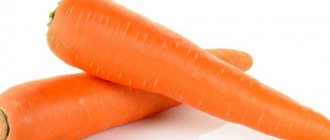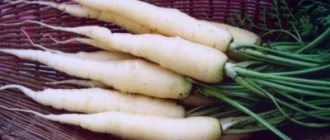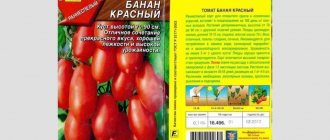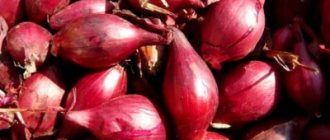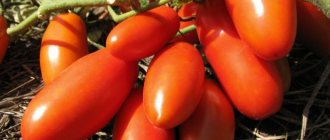Characteristics and description of the Red Giant variety
The carrot variety Red Giant is a translation from the German name ROTE RIESEN, a variety of German breeders.
- Appearance. The root crop is a conical, elongated shape that tapers to a pointed tip. The length of the carrot is 22-24 cm, thickness 4-6 cm. The root vegetable itself is orange-red in color and has a medium-sized core of the same color. The leaves of this carrot are very long, medium-dissected and dark green in color. The variety is not prone to shooting arrows and does not crack.
- Which variety does it belong to? Red Giant belongs to the Flakke (Valeria) variety. These are late-ripening carrots, suitable for long-term storage (read about late-ripening, early-ripening and mid-ripening varieties of carrots in a separate article).
- Amounts of fructose and beta-carotene. The root vegetable contains in 100 g:
- fructose – 7-8.8%;
- carotene – 10-12 mg.
- Sowing time. In spring, carrots are sown in April-May at a minimum soil temperature of +10 degrees Celsius. Pre-winter sowing is carried out in the fall at a temperature of +5 degrees Celsius. The germination rate of seeds of this variety is 70%. Germination period is 5-25 days.
- Average weight of 1 root vegetable. Its average weight is 150-180 g, and can reach up to 200 g.
- What is the yield from 1 hectare. The Red Giant carrot has a high yield of 300-500 c/ha.
- Purpose of the variety and keeping quality. This carrot variety can be used:
- fresh;
for salads;
- juice preparation;
- for freezing in grated form.
- Growing regions. The root crop is grown in most regions of Russia.
- Where is it recommended to grow? The variety is recommended by breeders for cultivation in the ground in the open air.
- Resistance to diseases and pests. It is highly resistant to diseases and pests.
- Maturing period. The ripening period ranges from 120 to 160 days depending on weather conditions, soil composition and moisture.
- What types of soil does he prefer? The Red Giant prefers loam and sandy loam soil. Slightly acidic soils are well suited.
- Frost resistance and transportability. The variety has excellent frost resistance and good transportability.
- Manufacturability of the variety for farmers and peasants. The Red Giant carrot variety is highly adaptable for cultivation by farmers and peasants. Modern technologies for cultivating this crop, harvesting and storing the crop have been developed. Convenient to clean and process for culinary purposes.
Has excellent keeping quality. If stored properly, the root crop can be used until the end of spring.
Heartless Queen
Heartless Queen carrots love the sun and can tolerate frosts down to -3 C. Choose sunny areas for sowing. Plant it in open ground.
Sowing is carried out in the spring, at a soil temperature of 3-5 C, or in the fall, when the soil freezes. The variety is mid-season. Root crops are grown for 120 days:
| № | Helpful information |
| 1 | the fruits are smooth, cylindrical, the eyes are not noticeable |
| 2 | average root length 20 cm, weight 240 g |
| 3 | compact bush. When sowing, adhere to the 4*20 cm pattern. To prevent the tops from shading the soil, it is recommended to mulch. Sand or sawdust is placed in the bed. Mulch will prevent the development of fungus |
| 4 | yield per 1 m2 is 6-8 kg |
| 5 | the crop grows well on sandstones and soft loams |
| 6 | the plant is resistant to viral and bacteriological infections. To avoid the development of fungus, ash and mineral fertilizers are used when preparing the soil for sowing. |
More on the topic: How to water carrots?
The seeds are planted in the beds to a depth of 2 cm. Sprinkled with a soil mixture of peat, sand and sawdust. The mixture is soft, the sprouts will rise from the ground without hindrance. On hard soils, seedlings take a long time to emerge; the roots develop pathologies and become deformed.
Advantages and disadvantages
The advantages of the Red Giant carrot variety are:
- high productivity;
- sweet and juicy;
- possibility of long-term storage while maintaining taste;
- excellent keeping quality;
- the variety is resistant to diseases and pests;
- versatility in use.
The disadvantages are:
- long ripening of root crops;
- demanding attitude to moisture;
- low seed germination.
Harvest and storage
It is recommended to start harvesting red carrots without cores after the ambient temperature drops to +8°C.
How and when to collect
When exposed to frosts of -2...-3°C, root crops are poorly stored and are affected by diseases. When harvesting, avoid mechanical damage and drying. Immediately after harvesting, trim the leaves. Root crops should not be covered with tops, as this promotes infection by pathogenic microorganisms.
Storage features and keeping quality of the variety
During storage at low temperatures and with minimal loss of moisture in the root vegetables of Red Heartless Carrots, the amount of dry matter, sugars, carotene, vitamin C, and protein remains constant.
The qualitative composition of sugars changes - the content of sucrose decreases, fructose and glucose increases. A natural process of preparation for resumption of growth occurs. At high temperatures, this change begins immediately; at low temperatures, the process slows down, as a result of which the carrots retain their sweetness longer.
Fruits emit ethylene, so it is not advisable to store red carrots next to them. Even a slight increase in the concentration of this gas in the storage air increases the intensity of respiration, which contributes to the formation of isocoumarin in carrots, which imparts bitterness.
Root crops with mechanical damage quickly lose moisture and are affected by diseases. Black indentations appear on the carrot skin and become filled with bacteria and fungi.
Carrots are stored in boxes, interlayered with sand, at a temperature of +2...+5°C, relative humidity 90-95%. Under such conditions, the root vegetables of Red Heartless Carrots remain fresh for 6 to 10 months. The freezing point of carrots is –1.6°C.
Growing
The optimal temperature at which the seeds of the Red Giant will sprout is +10 degrees Celsius.
For sowing, it is best to choose sandy loam soil with low acidity. Before planting, the area is fertilized with humus. The variety is demanding on soil looseness; it must be carefully prepared. A feature of sowing root crops is the increased distance between seeds - 4-5 cm.
Caring for the Red Giant involves regular watering. 14 days after the sprouts appear, the first thinning is done. The second is done when the diameter of the young carrots becomes about 2 cm.
Features of growing carrots of the Nantes variety
She needs good sunlight and regular watering.
Fresh manure is harmful for carrots; the root crops will be tasteless and clumsy, so it is preferable to sow them in the second year after cucumbers or tomatoes that have been abundantly fertilized with organic matter.
It is most advisable to purchase Nantes carrot seeds on a tape, offered by agro, "Gavrish" and "Aelita": they are easier to sow, and the seedlings are even and do not require thinning. Furrows are made in the garden bed at a distance of about 20 centimeters from each other and ribbons with seeds are placed in them, then sprinkled with a 1-2 centimeter layer of soil. When using seeds without a tape, the distance between the seeds in the row is maintained at about 4–5 centimeters.
Carrot seeds on a tape are very convenient to sow
Carrot sowing dates
Nantes carrots can be sown at different times:
- for early harvest in July - August and summer consumption - sowing before winter in October - November;
- for harvesting in September and long-term winter storage - sowing in spring in early May.
Winter sowing of carrots
The main trick of winter sowing is that the seeds should not germinate ahead of time, so it is necessary to sow after the onset of stable cold weather. For the middle zone this is the end of October - beginning of November . When sowing in winter, there is no need to water the garden bed; you can even spread the seeds on slightly frozen soil in prepared furrows and sprinkle them with dry soil. There is no need to additionally insulate the bed.
Spring sowing of carrots
In spring, the best time for sowing carrots in central Russia is from late April to mid-May. The seeded bed must be watered with water from a watering can with a strainer.
Carrot seedlings are not afraid of light frosts, but when covered with film or agrofibre they will grow faster.
If the carrots were sown with loose seeds and sprouted too densely, after emergence the carrots must be thinned out, leaving at least 4 centimeters between the plants in the row.
Diseases and pests
The Red Giant is amazed:
- Carrot fly. Its larvae eat roots and leaves, and the plant dies. To avoid this, it is necessary to promptly thin out the seedlings and remove weeds, and treat the plants with insecticides.
- Slugs. In very wet weather, slugs can develop and chew holes in root crops.
Among the diseases, the Red Giant is susceptible to Phomasis. The disease affects plants at the end of the growing season. Oblong gray-brown spots appear on the leaves and petioles. Phoma actively develops on fruits and continues its activity during storage. Dark depressions form on them.
Phomasis is almost impossible to cure. All affected plants must be removed. To prevent the disease, it is necessary to apply phosphorus-potassium fertilizers before planting.
Yellow carrots
Its roots are yellow or light yellow. The castnophil pigment is responsible for it. It is similar to beta-carotene. There is evidence that castnofil prevents cancer of internal organs. The lutein it contains protects the retina from the harmful effects of white light. Consuming it helps prevent the development of cardiovascular diseases.
Her homeland is Central Asia. Popular varieties developed are Mello Yello F1 and Yellowstone.
Problems during cultivation and ways to solve them
No matter how much we would like it, carrots, like any other plant on Earth, sometimes do not grow as we would like. The development of carrots is influenced not only by garden pests, but also by the growing region, the quality of the soil and care.
When growing the Red Giant, the following problems may arise:
- Unfriendly and low germination rate. The cause may be excessively dense soil. To eliminate this cause, you need to additionally loosen the soil and add sawdust and peat.
- Low sugar content. The cause may be highly acidified soil. Liming is necessary for deoxidation.
Reviews
In my opinion, the best Nantes. It has a thin core and good taste. We only plant it. Since last year we have been buying it on a ribbon (I really liked it, no need to pull it apart, it grows large and straight). We planted 2 ribbons of 10m each, about 5 buckets of excellent carrots grew (1 ribbon has 350 seeds). So I recommend it.
Cunning
https://dacha.wcb.ru/lofiversion/index.php?t11283.html
This is the second year we have been sowing Nantes carrots in granules, the seeds are called Lazy Bed, the carrots are large and even, and there is no need to thin them.
Julia
https://farmerforum.ru/viewtopic.php?t=676
Only for Nantes, my wife’s parents are from the Urals - they only imprison her, and they advised us.
Guest
https://www.mastergrad.com/forums/t155352-kakoy-sort-morkovi-vybrat/
I have been planting Nantes carrots for many years; my mother also planted them. I also buy other varieties, but Nantes is always in my garden. I’m very pleased - all the carrots are even, smooth, with rounded noses.
Napensia
https://otzovik.com/review_6174146.html
Tasty, productive and unpretentious Nantes carrots are one of the best varieties for Russian conditions, deservedly loved by farmers and gardeners.
Similar species to Rote Riesen
In Russia, carrot varieties are also used that are similar in their taste, ripening time, cultivation technology, frost resistance, and keeping quality, like the Red Giant. These are varieties such as:
- Berlicum Royal;
- Volzhskaya 30;
- Emperor;
- Queen of Autumn;
- Incomparable.
We suggest studying information about some other popular varieties of carrots. These include Touchon, Chantanay, Red Cor, Dordogne, Samson, Karotel and September.
Red Giant is still a new carrot variety , but thanks to its remarkable properties it can easily compete with other varieties. Considering its manufacturability and high yield, it will be readily used in farms and peasant farmsteads.
How long to water carrots
Daily watering can be stopped once clustering has occurred and you have completed final thinning. Further, irrigation will be sufficient, with a schedule of 2 times a week. It is believed that one watering, but of high quality, will bring more harvest than several, but a little at a time. Regarding moisture conservation, it has already been mentioned that you need to use grass and hay. Remember that this type of carrot prefers not only moisture, but also oxygen. So, if necessary, you will have to re-loosen, water, and mulch the bed.
What is the largest, sweetest, juiciest and most delicious vegetable?
The most delicious carrots are considered to contain a lot of sugar, which gives them a special sweetness and taste. Suitable for this category:
- Carrots are purple . Sweet carrots of small length and weight (about 130 grams) have a good taste.
- Vitamin carrots . The name speaks for itself: the vegetable contains up to 30 mg of nutrients, and the sugar level reaches 12%.
- Incomparable carrots . Contains many useful acids, carotene and 8% sugar, weighing 200 g.
The sweetest varieties of vegetables can be combined into a small table:
| Name | Ripening period | Form | Ripening time (days) | Storage time |
| Early. | Round, smooth. | 75-90. | 4 months. |
| Early. | Round, short. | 60-90. | Less than 1 month. |
| Average. | Cylindrical, medium length. | 95-120. | 6-7 months. |
| Late. | Narrow, elongated. | 120-140. | 6-8 months. |
The influence of growing conditions on the quality of root crops
Currently, breeders have developed so many varieties of carrots that it is impossible to list them all. They are classified according to such characteristics as shape, color, average weight of the root crop, taste properties, and duration of the growing season.
Small root vegetables are obtained in shaded areas. Thickened plantings produce thin, weak roots. Ugly, coarse specimens grow on clayey and hard soils, bitter specimens grow on acidic soils, and devoid of succulence in dry soil. When the soil is over-moistened, large, almost fodder carrots are obtained; excess manure leads to branching of the “tops” and curvature of the “roots”.
Please note: even good seeds can produce bad fruit. The appearance and quality of carrots is influenced by the place where they were grown, the soil, and care features.
Form
Root vegetables can be of various shapes - long, short, round, cylindrical and even spindle-shaped. Experienced gardeners know that shape affects the taste of carrots. Thus, long root vegetables are not distinguished by their juiciness, although they are very weighty, up to 30 cm long and weighing up to 0.5 kg. They are profitable and convenient to grow in small beds.
Popular varieties are Emperor, Valeria, Russian size, Vorobyovskaya. The Nantes variety, with its evenly cylindrical root crops and excellent taste, has long been loved by gardeners. The variety was bred by Soviet scientists back in 1943.
Many people prefer productive varieties with a short (Minicore) or rounded shape. Such vegetables are tender and sweet, making them easier to peel.
Round shaped varieties:
- Variety Polar cranberry
- Parisian cartel.
- Polar cranberry.
- Round baby.
- Parmex.
- Sophie.
Types of root vegetables by color
What color were carrots originally, why are they not only orange, but also yellow and red, that is, multi-colored, and does it have a real color?
Nature created carrots not only in 3 types, but also in different colors. The color of the root vegetable depends on the action of special coloring pigments - carotenoids, and forms the following colored types of vegetables:
- Violet . The shade can range from blue to black. The purple carrot came from its ancestor, originally from the East.
- White . White root vegetables (and this was originally the vegetable that later became known as carrots) spread from Ancient Rome throughout Europe and throughout the world.
- The orange and yellow colors of carrots were developed from seeds through centuries of selective breeding.
- Red and pink carrots . This color is due to the presence of xanthophylls and lycopenes - red plant pigments.
- Assorted . There are special varieties that allow you to grow root crops of all colors at the same time. For example, the Rainbow F1 variety.
